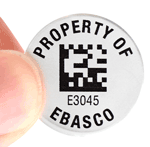The durability of your asset tag depends upon the application surface and the adhesive used on your asset tag or label. Our standard adhesives are suitable for most every application. But, if some of your equipment is rough or is cased in a hard-to-stick-to plastic, use our AlumiGuard® or PermaGuard® asset tags. Both can use a “soft” adhesives that can be used on these surfaces (as well as smooth surfaces). Also, these adhesives are suitable for application in below-freezing weather.
Preparation is 9/10's of the Battle.
How you apply your asset label or tag is also critical. Sticking an asset tag onto a poorly prepared surface is like trying to paint a dirty gutter - the asset tag is just not going to stay stuck for very long. Remember how important all the scrapping was when you repainted your house! Similarly, we recommend using a cleaning solution.
 Remove
oils. And, if possible, use a 3M Scotchbrite pad. For certain surfaces,
consider roughing up the surface slightly. The rougher surface gives more "tooth" and
more "hills and valleys" to hang on to. Finally, use our squeegee or roller to apply pressure on the asset tag. This will not mar the surface, but will also help rid your asset tag of trapped air bubbles.
Remove
oils. And, if possible, use a 3M Scotchbrite pad. For certain surfaces,
consider roughing up the surface slightly. The rougher surface gives more "tooth" and
more "hills and valleys" to hang on to. Finally, use our squeegee or roller to apply pressure on the asset tag. This will not mar the surface, but will also help rid your asset tag of trapped air bubbles.Have patience.
Most of the adhesives used on asset labels take 72 hours for final cure. An asset tag that can be removed cleanly after 30 minutes can become quite impossible to remove after 24 hours. Heating the application surface accelerates the cure time for the asset tag or label.
Match the Adhesive to the Surface.
We offer five adhesives for our metal tags. Also ask for samples .















